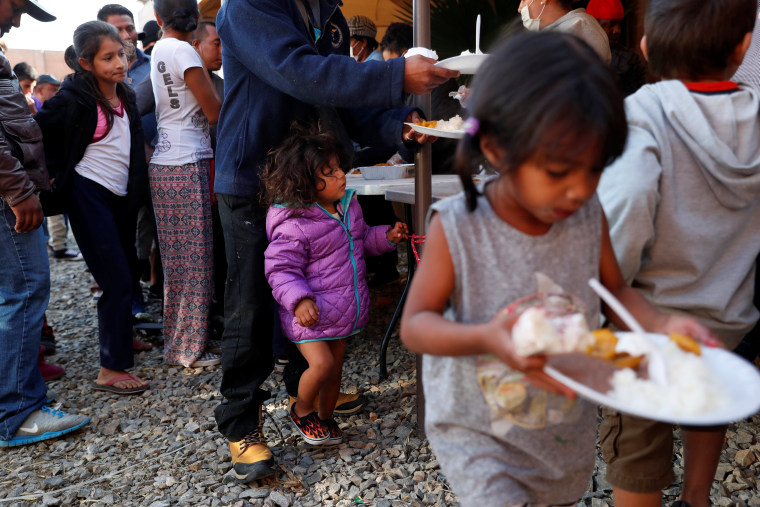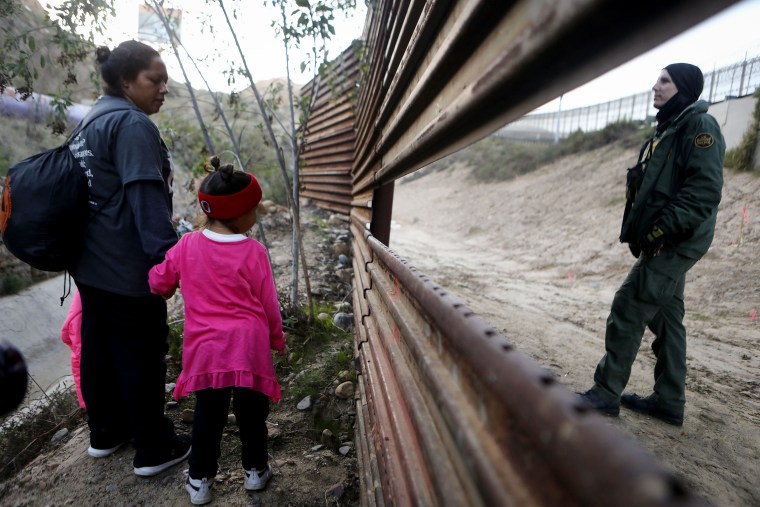LORDSBURG, New Mexico — Lawmakers came to the border looking for answers for why a young girl died while in Border Patrol custody.
But it isn’t the first time answers have been demanded of Customs and Border Protection in the death of an immigrant. Or the first time much went unanswered.
The death of Jakelin Caal Maquin, who became violently ill with vomiting, fever and seizures on a Border Patrol bus before she was airlifted to a hospital after a 90-mile bus ride, follows the death of Claudia Patricia Gomez Gonzalez, 19, of Guatemala, who was shot by a Border Patrol agent. The shooting is still being investigated.
Other cases of shootings, abuse, neglect and mistreatment have been documented in various reports over the years or were the subject of media coverage. Each time there are demands for more oversight, accountability and transparency from the agency.
Groups that keep tabs say Border Patrol remains mired in outdated policing methods, while attempts at reform that began in the Obama administration have slowed and regressed.
In El Paso Monday night, Rep.-elect Veronica Escobar thanked Washington Post reporters for revealing Jakelin’s death. Without their reporting, “Jakelin’s story may never have been made known to members of Congress or to the American people,” she said.
When he testified before the Senate Judiciary Committee on Dec. 11, four days after Jakelin died, Customs Border Commissioner Kevin McAleenan did not mention the girl’s death, even though he’s required to do so within 24 hours under a law enacted this year.
Rep. Joaquín Castro, D-Texas, called for McAleenan’s resignation on Tuesday for violating that law. He also asked when McAleenan’s boss, Homeland Security Secretary Kirstjen Nielsen learned of the girl’s death.
With the pressure and criticism escalating, CBP on Wednesday issued an order to the agency to inform Congress and the media within 24 hours of a death of someone in its custody.
Demanding accountability
“We have seen Border Patrol and (Immigration and Customs Enforcement) and CBP grow significantly over the last 15 years. What we have not seen has been growth in accountability and transparency,” Escobar said.
There have been attempts to reform the agency. Reps. Beto O’Rourke, D-Texas and Steve Pearce, R-N.M., reintroduced last June a bill titled the “Border Enforcement Accountability, Oversight and Community Engagement Act.” But it hasn’t advanced.
Speaking to reporters after Jakelin’s death, O’Rourke pointed out there have been years of complaints about mistreatment by CBP officers and agents and reports of migrants’ deaths under questionable circumstances while under Border Patrol custody.
Those complaints go “into a black hole,” O’Rourke said, according to an El Paso Times transcript of his comments.
“As sensational as this story (of Jakelin’s death) is right now, this is something that has been happening for years, decades and many of us have been trying to address and correct it,” O’Rouke said. “I hope that, perhaps, now that everyone is looking at this, we get the progress and change that we need.”
For years, groups have called for Border Patrol to use body cameras. This year, the American Civil Liberties Union released a report and 30,000 pages of federal records — obtained through an open government request — documenting complaints of abuse and mistreatment, including rape and assault of unaccompanied children by agents.
In 2014, the Los Angeles Times obtained and made public details of a report by the Police Executive Research Forum regarding the Border Patrol's use of force. The agency had tried to keep the report secret, refusing even to give a full copy to House and Senate committees.
“We need an entirely new sophisticated law enforcement approach to the border,” said Josiah Heyman, director of the Center for InterAmerican and Border Studies at The University of Texas at El Paso (UTEP).
Shift in migrations is 'no surprise'
McAleenan has said that the numbers of migrants arriving on the border near Lordsburg, in a remote stretch of the southwest desert, is a “brand new phenomenon.”
In just three days, 496 people turned themselves in at Antelope Wells port of entry, McAleenan said.
When he testified before the Senate Judiciary Committee on Dec. 11, McAleenan told the senators that CBP's facilities were built to handle “mostly male, single adults in custody, not families or children.”
“I want to make sure that we have the capability to care for children in our custody with the right medical and mental health professionals and that we have the partnership with Health and Human Services to expeditiously transfer children to a more appropriate custody situation," he said.
But the shift in migrations shouldn’t be a surprise, said Heyman. The Obama administration started seeing the changes when the arrivals of unaccompanied children and families spiked in 2014, and UTEP analysts told agency officials this was happening.
"Border Patrol is the most traditionalistic organization imaginable, entirely focused on arresting adult Mexican men,” said Heyman.
The immediate humanitarian crisis
As parts of the border have been fortified with fencing and other barriers over the years, migrants and smugglers have sought other entry points, moving to more treacherous parts of the nearly 2,000-mile United States-Mexico boundary.
Enrique Morones, the executive director of the humanitarian group Border Angels, said the group of about 30 to 35 volunteers who distribute the water every third Saturday has grown to about 500. The group now holds a hike every fourth Saturday to set out water.

Jakeline's death has led to questions about the medical assistance Border Patrol has on hand for migrants and their training levels.
Since 1998, Border Patrol has had search and rescue tactical teams, known as BORSTAR, created as injuries to agents and migrants deaths increased. Some of its team members have tactical medical training. A Border Patrol rescue often will be detailed by the agency in public news releases.
The Border Patrol said that in the 2018 fiscal year, which ran from Oct. 1, 2017 to Sept. 30, 2018, it rescued 4,307 migrants in danger, some in life-threatening situations.
There are 274 BORSTAR agents deployed throughout the southwest, the agency said. The agents relied on Hidalgo County Emergency Medical Services to airlift the girl to an El Paso, Texas hospital.
There are no medical personnel permanently assigned to Antelope Wells or Bounds Forward Operating Base and no EMT personnel were on duty when Jakelin and her father were taken into custody. CBP said 1,300 Border Patrol agents have been trained as EMTs (Emergency Medical Technicians).
Jakelin's death drew a rebuke from the American Academy of Pediatrics , who said Jakelin's death was preventable. Someone trained in pediatrics could have taken her vitals and looked for signs of dehydration and the potential for septic shock and provided treatment or medical intervention sooner.
“Until we have pediatric-trained personnel who have access to these facilities and these children, we’re just waiting until the next death happens,” said Dr. Colleen Kraft, the Academy's president.
The American Academy of Pediatrics wrote a letter to McAleenan and the Trump administration calling for an investigation.

“Many of our organizations have sought to provide expert advice to the federal government, including your agency, about how to best care for and treat immigrant children and pregnant women in your custody. That offer still stands," the letter said.
Legislation that would require CBP to hire child welfare professionals at ports of entry and border stations would help children as well as border agents, advocates said.
“It helps CBP as much as it helps the kids," said Jennifer Podkul, senior director for policy and advocacy at Kids In Need of Defense. "You're allowing CBP officers to do the law enforcement they were trained to do and ensuring that kids are being treated appropriately and their immediate medical needs are addressed while they are in the short term holding.”
A flexible medical response
Speaking of Jakelin's death, Texas Republican Rep. Will Hurd said recently the Inspector General is reviewing the case to see what happened and if there was negligence, "but also reviewing whether CBP has the resources they need in order to handle a situation like this — I think this example leads us to believe that they don't have those resources.”
Rep. Raul Ruiz, an emergency care physician with experience in humanitarian disaster response, said he was troubled by the lack of medical equipment and knowledge at the Antelope Wells port of entry and the Forward Operating Base — even for taking vital signs and doing a routine physical exam — as well as the overcrowded conditions in the Lordsburg Border Patrol station.
In Lordsburg, "they were on the concrete floor with those paper thin aluminum-foil type blankets, so packed that you couldn’t even see any floor space," Ruiz said. "And these were women with young children, a lot under 5, toddler ages. When I looked around some looked sick, [or] had a cold. It looked like they hadn't bathed in days."
Ruiz said he has cared for people in very difficult and improvised conditions as a disaster response physician, including in post-earthquake Haiti, "and I haven't seen anything like this."
He said CBP needs to "find flexibility within their staffing on the border" and immediately send personnel with medical training to areas where they encounter large groups of families. CBP facilities need to be equipped with medical equipment for exams and emergency resuscitation.
Ruiz said his office had been told the CBP commissioner is making sure the facilities have appropriate medical bags.
One suggestion, said Ruiz, is to tap medically trained personnel from Health and Human Services, FEMA and and the Disaster Medical Assistance Team; people in those agencies are trained to be quickly mobilized to disaster areas. They could be called on to set up a tent clinic or hospital in areas where migrants have shown up in large numbers, he said.
"Resources exist if they can mobilize and spread them out and be flexible when they have a massive change in migration patterns," Ruiz said.
Communications equipment needs to be upgraded in remote areas; Ruiz said the agents in Antelope Wells did not have the infrastructure to connect them with the local 911 system. While they can communicate with one another by radio, they have to use cell phones to call 911.
"During long periods of the ride on that road from Antelope Wells to Lordsburg, there was no cell phone coverage," Ruiz said.
According to CBP, the agency is looking at increasing the number of medical personnel at its facilities and has already increased resources to the El Paso sector, which includes El Paso and Hudspeth counties and all of New Mexico.
"CBP agents do a good job making sure guns, drugs and criminals don’t come over and don’t cross our borders. It's necessary they do that," said Ruiz. "However, we are experiencing a humanitarian crisis, people are crossing the border seeking asylum. Once they are in custody of CBP, they are under the responsibility of CBP for their health and welfare."
FOLLOW NBC LATINO ON FACEBOOK, TWITTER AND INSTAGRAM.



